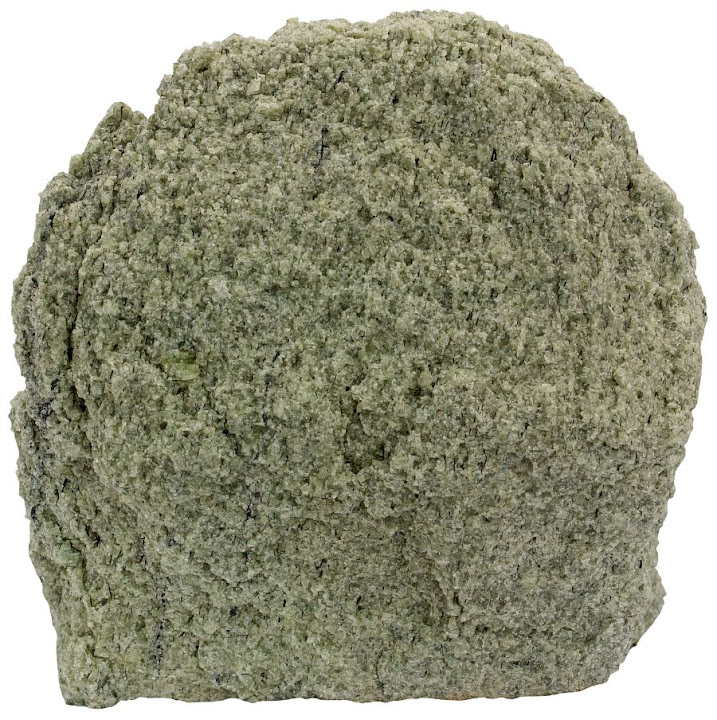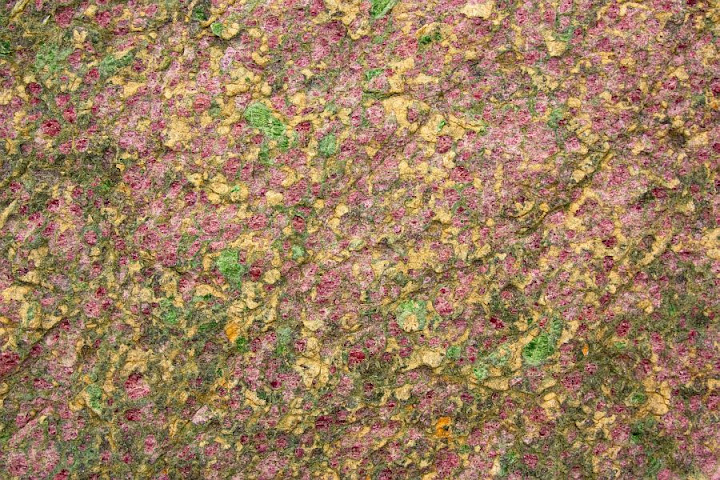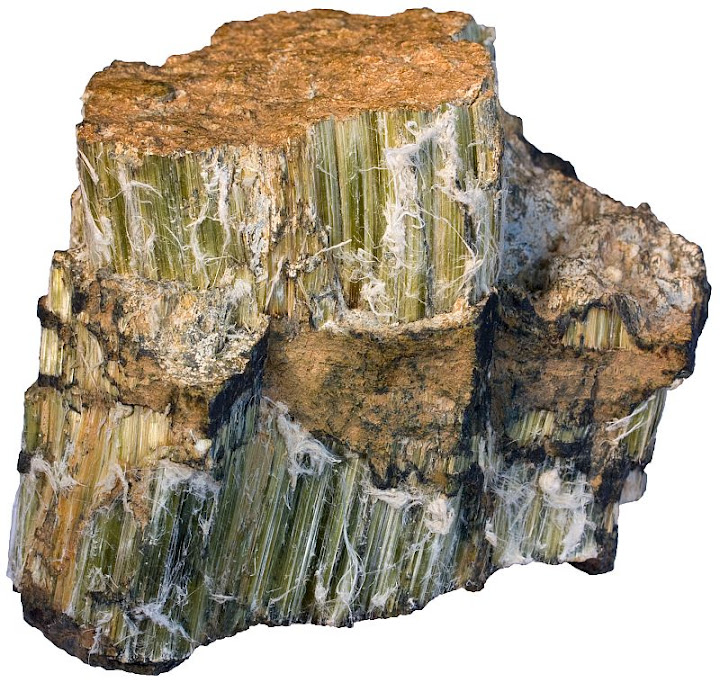Olivine is a very common silicate mineral that occurs mostly in dark-colored igneous rocks like peridotite and basalt. It is usually easily identifiable because of its bright green color and glassy luster.

Olivine sand grains from Hawaii. Olivine is actually very rare in sand because it is highly susceptible to weathering. There is little hope of finding olivine grains in continental sand. If there are bright green grains, it is most likely epidote. However, volcanic oceanic islands like Hawaii, Canary Islands, Galápagos, etc. have black beaches which are mostly composed of pyroxenes, olivine, magnetite, and other components of mafic rocks. Most of these minerals will not last long as sand grains, but they still dominate because there simply is no quartz available on these islands. The sample is from Papakolea, Hawaii. Width of view 20 mm.
Olivine is a common mineral in dark-colored igneous rocks because these rocks are rich in iron and magnesium (rocks rich in iron-bearing minerals tend to be either black or at least dark-colored). These chemical elements (Mg and Fe) are the essential components of olivine which has the following chemical formula: (Mg,Fe)2SiO4. Magnesium and iron can replace each other in all proportions. There are specific names for compositional varieties, but most of them are rarely used. Only forsterite (more than 90% of the Mg+Fe is Mg) and fayalite (similarly iron-rich endmember) are used more often. The vast majority of all the samples are forsteritic or compositionally close to it.
Olivine is a nesosilicate. It means that silica tetrahedra (which is the central building block of all silicate minerals) are surrounded from all sides by other ions. Silica tetrahedra are not in contact with each other. It implies relatively low content of silicon which is indeed the case. It is a silicate mineral that uses silicon very conservatively. On the other end of the spectrum is mineral quartz which is pure silica (SiO2) without any other constituents. Other well-known nesosilicates are garnet, zircon, topaz, kyanite, etc.
Silicate minerals that crystallize from magma have a higher melting/crystallization temperature if the content of silica is lower and the content of Mg+Fe is higher. Hence, olivine has a high crystallization temperature and is therefore one of the first minerals to start crystallizing from a cooling magma. It takes silica out of magma relatively conservatively, as already mentioned. So the concentration of silica rises as olivine crystals form and next silicate minerals to crystallize (which are pyroxenes) are already somewhat richer in silica. This sequential order of crystallizing silicate minerals from olivine to quartz is known as the Bowen’s reaction series after a Canadian geologist Norman Bowen who first described it. It is one of the most important concepts every geology student is taught during the petrology course.

Dunite xenolith in basaltic lava from Hawaii. The sample is 8 cm in width.
Bowen’s series or order of minerals in this series (olivine -> pyroxene -> amphibole -> biotite -> K-feldspar -> muscovite -> quartz) is a really useful one to memorize and there are several properties of these minerals that generally follow the same order. Olivine and its close neighbors are darker, contain iron and magnesium, and have a high melting temperature. Quartz, muscovite and K-feldspars are generally much lighter in color and weight, they melt at lower temperatures, and they contain no iron and magnesium. Another interesting fact is that the order of susceptibility to weathering and metamorphic alteration is exactly the reverse. It is readily altered or weathered while quartz is extremely resistant to any kind of change. All other minerals in the series are somewhere in the middle. In the correct order, of course.
Important aspect that rises from this series is the explanation why certain minerals typically form assemblages while others are almost never found together. Olivine is typically with pyroxenes (in basalt, for example) and quartz + K-feldspar with micas (biotite and muscovite) is a typical composition of granite. But there are no such rock types that are composed of olivine plus quartz. Granite and similar rocks are said to be felsic (composed of feldspar and silica) and basaltic rocks are referred to as mafic rocks (magnesium + ferric).
Olivine is a common rock-forming mineral in mafic and ultramafic igneous rocks, but it also occurs in impure metamorphosed carbonate rocks (picture below). It is a very common mineral in the mantle. Some xenoliths from the mantle are almost entirely composed of this mineral. Such a rock type is known as dunite. Olivine occurs as a groundmass mineral but also as distinct phenocrysts in many basaltic rocks. These rocks need not to be basalts in the strict sense. They may be picrites, basanites, etc. but all of them may be very similar to each other as boundaries between them are arbitrary. So it is frequently impossible to say for sure before chemical analysis is made.
Olivine is very susceptible to weathering. Bright green mineral loses its appeal rapidly in the weathering environment. It becomes dull, earthy, and yellowish brown. This material is usually a mixture of clay minerals and iron hydroxide goethite and it is known as iddingsite. It also demonstrates very little resistance to hydrothermal metamorphism. Hot and chemically aggressive fluids quickly alter olivine-rich igneous rocks into metamorphic rock known as serpentinite. It is also an important constituent of many stony and mixed meteorites. Especially beautiful is pallasite. It is a mixture of iron and olivine and is thought to represent a core-mantle boundary of a disintegrated asteroid. Perhaps the core-mantle transition of our own home planet looks something like that too.
However, there is one little thing to remember. The mantle is indeed most likely compositionally close to it, but most of it is not composed of this exact mineral. Olivine tolerates well pressures in the crust and in the upper mantle, but at 350 km depth its crystal structure starts to break down. The composition remains, but it takes a new and more compact form. It is not technically olivine anymore because minerals have a definite crystal structure.

Olivine is not just an igneous mineral. It also occurs in impure metamorphosed carbonate rocks. Here olivine crystals are found in a sample of calcitic marble. Some crystals even possess a typical crystal faces which are usually lacking in igneous rocks because olivine grains are often corroded (they reacted with the melt surrounding them). Width of sample is 9 cm.

Phenocrysts in ultramafic picritic rock from La Palma, Canary Islands. Width of sample is 5 cm.

Weathered olivine is dull, earthy, and usually yellowish brown mixture of clay minerals and iron hydroxides. Black grains are pyroxene phenocrysts. Rock sample is basanite (ankaramite) from La Palma.

Dunite with dark green chlorite. Helgehornsvatnet, Norway. Width of sample 11 cm.

Basalt or picrite from Oahu with lots of slightly weathered olivine. Width of sample 6 cm.

A sample of dunite which is composed of almost pure olivine. It is mined because of its high forsterite content. Olivine is used mostly as a refractory material. Width of sample 9 cm.

Olivine (orange weathered spots) is a major component of gabbroic rock troctolite. Gray is plagioclase. Flakstadøya, the Lofoten Archipelago, Norway. Width of sample 15 cm.

Olivine (yellow) with pyrope (purple) and chromian diopside (green) in peridotite. Åheim, Norway. Width of view 25 cm.

Chrysotile is an asbestos mineral that belongs to the serpentine group of minerals. These minerals are the result of hydrothermal alteration of olivine-rich igneous rocks. Width of sample from the Sayan Mountains in Siberia is 8 cm.

It is a common constituent of black sand on the oceanic islands. Here are the most important constituents of one sand sample from the São Miguel Island, The Azores Archipelago. Note that olivine grains have a variable appearance (in two piles). This is the result of weathering that quickly attacks this mineral. Width of view 19 mm.
Can you please advice me if I use serpentinized olivine to make asphalt mixture. Is it affect the durability of laid asphalt
Regards
Sanjeev
Mr. Sanjeev,
I am not an asphalt expert, but the weathering of Olivine (and serpentinized Olivine) will be slowed down in the asphalt matrix. In addition is the weathering a process of years. Typically is the weathering rate around 1 micrometer per year (if exposed to CO2 and water). So in an asphalt matrix even slower. A typical life time of a road is about 30 years, so in that aspect there won’t be a problem.
The “glueing” of the olivine with the asphalt-matrix is another important consideration.
Succes with your application.
Pol Knops